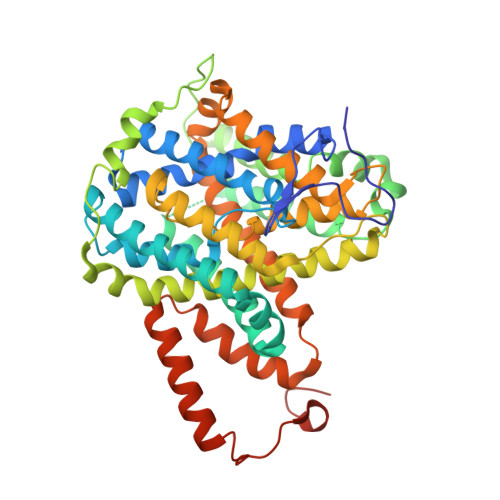Structure of a NAT transporter
Weng, J., Zhou, X., Ren, Z., Chen, K., Zhou, M.To be published.
Experimental Data Snapshot
Entity ID: 1 | |||||
|---|---|---|---|---|---|
| Molecule | Chains | Sequence Length | Organism | Details | Image |
| Putative membrane protein PurT | 471 | Colwellia psychrerythraea | Mutation(s): 0 Gene Names: CPS_4258 Membrane Entity: Yes |  | |
UniProt | |||||
Find proteins for Q47WB4 (Colwellia psychrerythraea (strain 34H / ATCC BAA-681)) Explore Q47WB4 Go to UniProtKB: Q47WB4 | |||||
Entity Groups | |||||
| Sequence Clusters | 30% Identity50% Identity70% Identity90% Identity95% Identity100% Identity | ||||
| UniProt Group | Q47WB4 | ||||
Sequence AnnotationsExpand | |||||
| |||||
| Ligands 1 Unique | |||||
|---|---|---|---|---|---|
| ID | Chains | Name / Formula / InChI Key | 2D Diagram | 3D Interactions | |
| GUN (Subject of Investigation/LOI) Query on GUN | C [auth A], D [auth B] | GUANINE C5 H5 N5 O UYTPUPDQBNUYGX-UHFFFAOYSA-N |  | ||
| Length ( Å ) | Angle ( ˚ ) |
|---|---|
| a = 131.713 | α = 90 |
| b = 135.993 | β = 90 |
| c = 79.169 | γ = 90 |
| Software Name | Purpose |
|---|---|
| PHENIX | refinement |
| HKL-2000 | data reduction |
| HKL-2000 | data scaling |
| PHENIX | phasing |
| Funding Organization | Location | Grant Number |
|---|---|---|
| National Institutes of Health/National Institute of General Medical Sciences (NIH/NIGMS) | United States | R01 GM119396 |